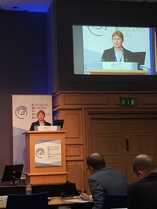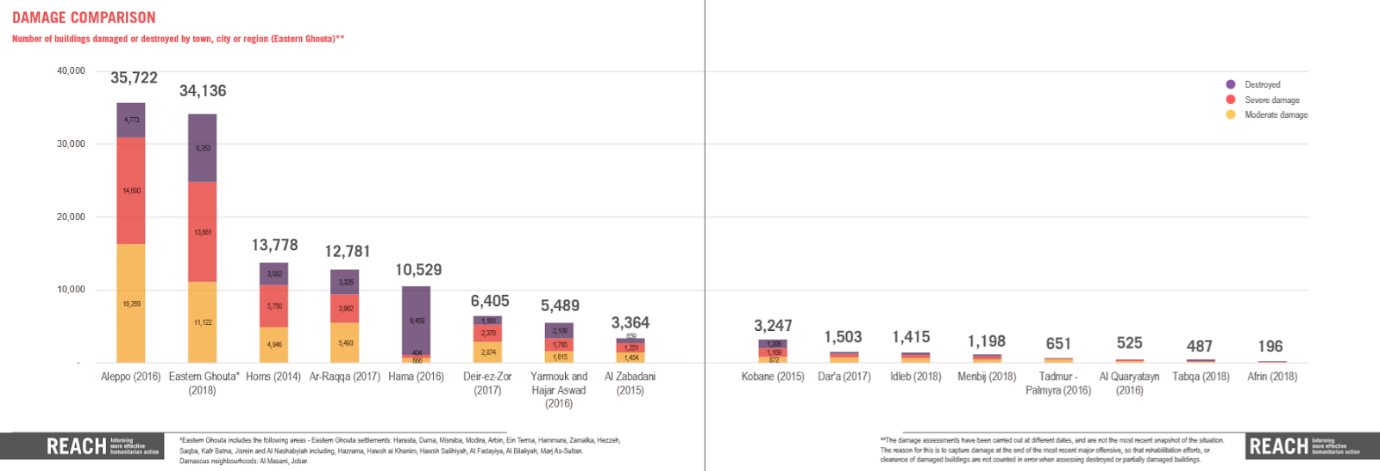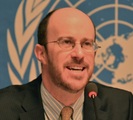| This is the sixth blog post in a series looking at an array of issues in 2024 related to weapons use, the arms trade and security assistance, often offering recommendations. |
“The biggest challenge in this war is dealing with my children’s fear during the constant bombings. Evacuation is tough, moving from one place to another with my two children with disabilities, trying to appear strong despite my own fears. Sadly, nowhere is safe in Gaza anymore.”
Testimony from Hani, staff member of Humanity & Inclusion in Gaza
2023 was a bleak year for the protection of civilians from explosive weapons. Data collected by Action on Armed Violence (AOAV) indicates that use of explosive weapons increased in 2023 and was experienced across a greater number of countries than the previous year, and that more civilians were killed and injured from explosive weapon use than in recent years.
The unrelenting bombing and shelling of Gaza after the Hamas attacks of 7 October, the eruption of conflict in Sudan, and continued fighting in Ethiopia, Myanmar, Syria, Ukraine and Yemen all led to increased documented civilian harm from the use of explosive weapons. In short, the use of explosive weapons in populated areas remains widespread and continues to be one of the greatest threats to civilians in armed conflicts today.
The endorsement by 83 states of the Political Declaration on Strengthening the Protection of Civilians Arising from the Use of Explosive Weapons in Populated Areas in Dublin in November 2022 was welcomed by many as a milestone achievement. The Declaration is a recognition of this grave humanitarian problem, an expression of solidarity with those affected, and a commitment to take further action to strengthen the protection of civilians both during and after conflict. But it will only succeed in better protecting civilians if it is implemented effectively by endorser states.
Driving forward change and building new norms and expectations for behaviour takes time. Moving away from use of explosive weapons in populated areas – through the framework of the Declaration and associated revisions to policy and practice – is a long-term undertaking that must begin expeditiously at a national level.
So, what do we want to see in this area of work and under the framework of the Political Declaration in 2024? What does progress on this issue look like and what opportunities exist to push this agenda along in an effective way internationally?
- States that have endorsed the Declaration start to operationalise it through national-level policy reviews and changes to practice.
Joining the Declaration comes with an expectation that changes should take place in national-level policy and practice. States should therefore review their commitments under the Political Declaration against existing national policies and practice.
A good first step to beginning the process of implementation is to identify a focal point in government responsible for coordination and oversight. The focal point should review the Declaration and its commitments, looking at how existing policies and practice can be strengthened or new ones developed, and where/how the Declaration needs to be disseminated domestically. A key priority will be to ensure dissemination of the Declaration to armed/defence forces at different levels given the crucial changes required in the areas of military doctrine and policy, as well as of training, planning and conduct of military operations. It will also be essential that states approach implementation through a humanitarian lens, focused on harm reduction and strengthening the protection of civilians.
Many states will have existing relevant policies and procedures on the conduct of military operations, and some may have tools to assess and mitigate harm to civilians. But there are specific commitments in the Declaration that need to be implemented, including placing restrictions on the use of explosive weapons, and making determinations on when it will be necessary to refrain from such use entirely, and how this is done. International Network on Explosive Weapons calls on states to refrain from using explosive weapons with wide area effects in populated areas, and to otherwise restrict the use of other explosive weapons in populated areas due to the likely risk of civilian harm.
The Declaration also puts considerable emphasis on addressing indirect or so-called “reverberating” effects, that stem from damage to and destruction of critical civilian infrastructure, in the planning and conduct of military operations. Other key priority areas include establishing mechanisms to collect and share data on direct and indirect effects on civilians and civilian objects, and providing assistance to conflict-affected communities.
The International Network on Explosive Weapons has put together a “Questions and Answers” document on implementation of the Declaration, and in a few weeks’ time will be launching an “Implementation Framework” with further guidance for states on undertaking this process.
- The first meeting to review implementation of the Declaration takes stock of the state of play and sets direction for the period ahead.
Norway will convene the first meeting under the framework of the Political Declaration since its endorsement in November 2022. The Oslo conference will take place on 23 April 2024, with a civil society forum the day before on 22 April, co-convened between International Network on Explosive Weapons and the Norwegian Red Cross which will invite state delegates to participate alongside civil society in a day of discussion and exhibitions.
The official conference aims to review implementation of the Declaration over the preceding 17-months, by giving space to discussions on approaches to implementation, opportunities to share examples of good policy and practice, and by sharing challenges and needs. It will also be important that it provides a clear sense of direction and stimulates efforts for the work ahead, by setting out priority areas for implementation and a road map for the coming year or so until states meet again.
The conference should also shine a spotlight on the devastating humanitarian consequences of explosive weapon use, especially given the recent and notable contexts where civilians continue to suffer immensely from explosive weapons use, as well as maintaining a focus on reducing civilian harm and suffering.
Norway has invited all endorsing states and other interested states to participate in the conference, alongside civil society organisations, the United Nations and the International Committee of the Red Cross (ICRC). As such, it should be an opportunity to both encourage some new states to join ahead of, or at, the Oslo conference, and to start to build a community of practice. Working in partnerships of states, civil society and international organisations provided a solid foundation for developing the Declaration. Maintaining these partnerships and dialogue between states, their armed forces, and humanitarian organisations is going to be just as critical in this next phase of work around its implementation.
- More countries join the Political Declaration
Whilst a broad range of states joined the Declaration in Dublin, no new countries have joined the Declaration since. A key aim ahead of the Oslo is for more countries to join this agreement, including across all world regions.
At the end of January, a regional workshop in Togo for West African states will be an important opportunity to encouraging more endorser states from this subregion, as well as Africa more broadly, to join.
During the Declaration negotiations and the Dublin adoption conference, the war in Ukraine and civilian suffering in Mariupol, Kharkiv and other cities placed the explosive weapons issue high on the agenda of many states, prompting their endorsement of the Declaration. The disastrous humanitarian consequences and stark examples of civilian suffering and harm from urban warfare that we have seen over the past year in Gaza, Myanmar, Sudan, and elsewhere should continue to provide impetus and show that this Declaration and issue is more relevant than ever and a global issue of concern for all states.
- The Declaration starts to set new norms and expectations for behaviour.
In addition to national level implementation, efforts must continue to raise awareness and understanding of this humanitarian issue, including through promotion of the Declaration and its commitments. By doing so, and by highlighting the goal and purpose of the Declaration – to reduce civilian harm and suffering – new norms and standards can be set and will start to take hold.
Speaking out in response to bombardment of populated areas and when civilians suffer is an important means to stigmatise harmful behaviour and to help establish new global norms for civilian protection. In the world today, the use of explosive weapons in populated areas is the cause of immense civilian harm and suffering in Gaza, Ukraine and elsewhere. States must be attentive to acknowledging this harm, wherever it takes place, and whichever actor is responsible.
Whilst it is perhaps too soon to expect to see a reduction in civilian casualties, or other significant reductions in harm, it is never too soon to start work towards this goal.
Laura Boillot is a Director at Article 36 and Coordinator for the International Network on Explosive Weapons (INEW).
Inclusion on the Forum on the Arms Trade expert list, and the publication of these posts, does not indicate agreement with or endorsement of the opinions of others. The opinions expressed are the views of each post's author(s).
















 RSS Feed
RSS Feed